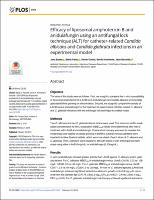Efficacy of liposomal amphotericin B and anidulafungin using an antifungal lock technique (ALT) for catheter-related Candida albicans and Candida glabrata infections in an experimental model
Author
Date
2019-02-19Permanent link
https://hdl.handle.net/11351/3837DOI
10.1371/journal.pone.0212426
ISSN
1932-6203
WOS
WOS:000459062900054
PMID
30779771
Abstract
OBJECTIVE:
The aims of this study were as follows. First, we sought to compare the in vitro susceptibility of liposomal amphotericin B (LAmB) and anidulafungin on Candida albicans and Candida glabrata biofilms growing on silicone discs. Second, we sought to compare the activity of LAmB versus anidulafungin for the treatment of experimental catheter-related C. albicans and C. glabrata infections with the antifungal lock technique in a rabbit model.
METHODS:
Two C. albicans and two C. glabrata clinical strains were used. The minimum biofilm eradication concentration for 90% eradication (MBEC90) values were determined after 48h of treatment with LAmB and anidulafungin. Confocal microscopy was used to visualize the morphology and viability of yeasts growing in biofilms. Central venous catheters were inserted into New Zealand rabbits, which were inoculated of each strain of C. albicans and C. glabrata. Then, catheters were treated for 48h with saline or with antifungal lock technique using either LAmB (5mg/mL) or anidulafungin (3.33mg/mL).
RESULTS:
In vitro: anidulafungin showed greater activity than LAmB against C. albicans and C. glabrata strains. For C. albicans: MBEC90 of anidulafungin versus LAmB: CA176, 0.03 vs. 128 mg/L; CA180, 0.5 vs. 64 mg/L. For C. glabrata: MBEC90 of anidulafungin versus LAmB: CG171, 0.5 vs. 64 mg/L; CG334, 2 vs. 32 mg/L. In vivo: for C. albicans species, LAmB and anidulafungin achieved significant reductions relative to growth control of log10 cfu recovered from the catheter tips (CA176: 3.6±0.3 log10 CFU, p≤0.0001; CA180: 3.8±0.1 log10 CFU, p≤0.01). For C. glabrata, anidulafungin lock therapy achieved significant reductions relative to the other treatments (CG171: 4.8 log10 CFU, p≤0.0001; CG334: 5.1 log10 CFU, p≤0.0001).
CONCLUSIONS:
For the C. albicans strains, both LAmB and anidulafungin may be promising antifungal lock technique for long-term catheter-related infections; however, anidulafungin showed significantly higher activity than LAmB against the C. glabrata strains.
Keywords
Liposomal amphotericin B; Antifungal lock technique; Candida albicansBibliographic citation
Basas J, Palau M, Gomis X, Almirante B, Gavaldà J. Efficacy of liposomal amphotericin B and anidulafungin using an antifungal lock technique (ALT) for catheter-related Candida albicans and Candida glabrata infections in an experimental model. PLoS One. 2019;14(2):e0212426.
Audience
Professionals
This item appears in following collections
- HVH - Articles científics [4471]
The following license files are associated with this item:

 Private area
Private area Contact Us
Contact Us








